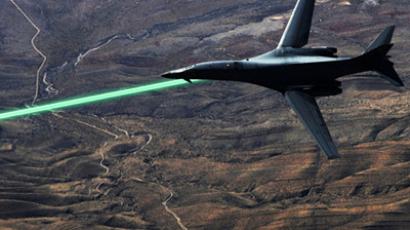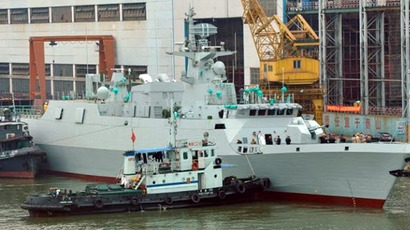US to deploy new laser weapon to Persian Gulf

Though drones may be getting most of the attention these days, the US Navy is getting set to deploy its first solid-state laser weapon aboard the USS Ponce in what it calls an “at-sea demonstration,” a technology that could revolutionize global warfare.
The new Laser Weapon System (LaWS) is said to have successfully destroyed at least one test drone, according to the US Navy, and its deployment aboard the Ponce, a ship that has come to be known as a floating forward staging base, suggests government confidence in the technology.
Video released by the Navy depicts the laser battery mounted aboard the USS Dewey, an Arleigh Burke-class guided missile destroyer, successfully targeting a moving drone, and engulfing it in flames.
Though the technology behind the development of concentrated laser weapons has been around for decades and was popularized during the Reagan Administration’s 'Star Wars' anti-ballistic missile program, it has only been within the last few years that the US military has begun producing practical adaptations.
Though there is no indication that lasers field tested by the US can realistically intercept an intercontinental ballistic missile (ICBM) at this point, the pressure is on for the Navy’s latest project. The hope behind the costly development of systems like solid state lasers is that one day they may begin to phase out traditional guided missiles and artillery.
Considering that a single tactical Tomahawk cruise missile costs the US $1.4 million, developing a laser that can someday approximate its capabilities at $1 per shot would be a radical advance. As for the laser battery being deployed aboard the USS Ponce, that technology is being described by sources like Wired Magazine as essentially a big cousin to commercial welding units, and being limited in the amount of power they can generate.
Nevin Carr, a retired two-star admiral who spoke with Wired, described the laser being fitted aboard the Dewey as effective against targets such as UAVs and “small, fast-swarming boats.”
Perhaps not coincidentally, Iran operates such vessels along the Strait of Hormuz, the critical navigation point for a large percentage of the world’s oil supply, and a region it has threatened to blockade in the past.
Peter A. Morrision, program officer for the Solid-State Laser Technology Maturation Program, seemed to gush at prospects for the new laser system.
"The future is here. The solid-state laser is a big step forward to revolutionizing modern warfare with directed energy, just as gunpowder did in the era of knives and swords," said Morrision.
Just how “mature” the new weapon truly is remains to be seen, though with the development of drones by practically every significant military power developing a low-cost weapon that could destroy these even at close range would be a huge advantage for the US.
Regardless, it seems safe to say that laser technology is poised
to finally exceed the great amount of empty hype it has produced
since the Cold War.














